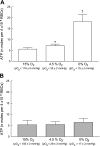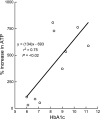Divergent effects of low-O(2) tension and iloprost on ATP release from erythrocytes of humans with type 2 diabetes: implications for O(2) supply to skeletal muscle
- PMID: 20511412
- PMCID: PMC2930397
- DOI: 10.1152/ajpheart.00430.2010
Divergent effects of low-O(2) tension and iloprost on ATP release from erythrocytes of humans with type 2 diabetes: implications for O(2) supply to skeletal muscle
Abstract
Erythrocytes release both O(2) and a vasodilator, ATP, when exposed to reduced O(2) tension. We investigated the hypothesis that ATP release is impaired in erythrocytes of humans with type 2 diabetes (DM2) and that this defect compromises the ability of these cells to stimulate dilation of resistance vessels. We also determined whether a general vasodilator, the prostacyclin analog iloprost (ILO), stimulates ATP release from healthy human (HH) and DM2 erythrocytes. Finally, we used a computational model to compare the effect on tissue O(2) levels of increases in blood flow directed to areas of increased O(2) demand (erythrocyte ATP release) with nondirected increases in flow (ILO). HH erythrocytes, but not DM2 cells, released increased amounts of ATP when exposed to reduced O(2) tension (Po(2) < 30 mmHg). In addition, isolated hamster skeletal muscle arterioles dilated in response to similar decreases in extraluminal O(2) when perfused with HH erythrocytes, but not when perfused with DM2 erythrocytes. In contrast, both HH and DM2 erythrocytes released ATP in response to ILO. In the case of DM2 erythrocytes, amounts of ATP released correlated inversely with glycemic control. Modeling revealed that a functional regulatory system that directs blood flow to areas of need (low O(2)-induced ATP release) provides appropriate levels of tissue oxygenation and that this level of the matching of O(2) delivery with demand in skeletal muscle cannot be achieved with a general vasodilator. These results suggest that the inability of erythrocytes to release ATP in response to exposure to low-O(2) tension could contribute to the peripheral vascular disease of DM2.
Figures






References
-
- Bagi Z, Koller A, Kaley G. Superoxide-NO interaction decreases flow- and agonist-induced dilations of coronary arterioles in type 2 diabetes mellitus. Am J Physiol Heart Circ Physiol 285: H1404–H1410, 2003 - PubMed
-
- Behnke BJ, Kinding CA, McDonough P, Poole DC, Sexton WL. Dynamics of microvascular oxygen pressure during rest-contraction transition in skeletal muscle of diabetic rats. Am J Physiol Heart Circ Physiol 283: H926–H932, 2002 - PubMed
-
- Collins DM, McCullough WT, Ellsworth ML. Conducted vascular responses: communication across the capillary bed. Microvasc Res 56: 43–53, 1998 - PubMed
-
- Collison DJ, Rea R, Donnelly R. Masterclass series in peripheral arterial disease. Vasc Med 9: 307–310, 2004 - PubMed
-
- Dazel HH, Westfall DP. Receptors for adenine nucleotides and nucleosides: subclassification, distribution and molecular characterization. Pharmacol Rev 46: 449–466, 1994 - PubMed
Publication types
MeSH terms
Substances
Grants and funding
LinkOut - more resources
Full Text Sources
Medical

